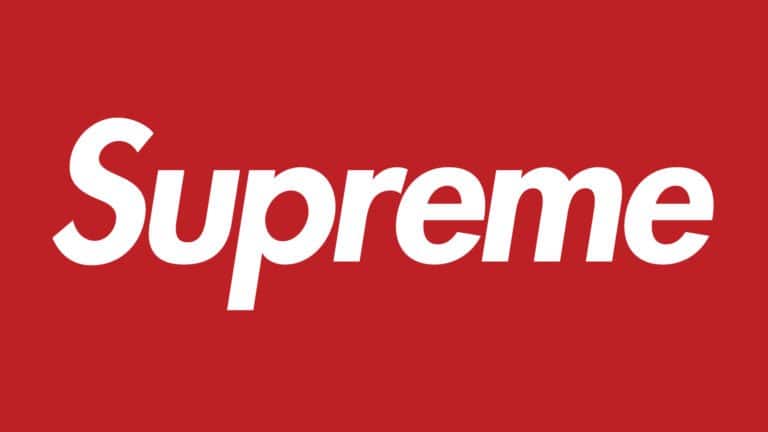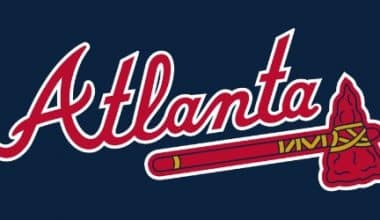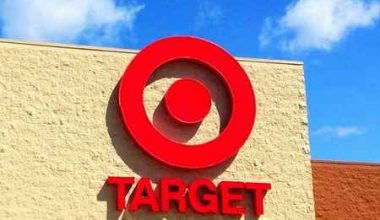Supreme, a skateboarding and apparel brand, carved out a very successful niche for its products by catering to the underground culture of skateboarding, hip hop, and rock. Today, Supreme has established itself as one of the world’s most popular streetwear brands , boasting major collaborations with companies such as Nike, North Face, Playboy, and many others, as well as record-breaking sellout times for newly released products.
Given the brand’s and logo’s enormous success in recent years, it should come as no surprise that the Supreme logo is now one of the most recognizable logos in the street-wear industry. The story of how Supreme achieved this level of success, as well as how their iconic logo came to be, is one that includes both high points of astounding success and instances of significant controversy. But we will go over them regardless.
Supreme Logo: History
When James Jebbia opened the first Supreme store in Manhattan, the main goal was to sell products from other brands that were popular among skaters. Jebbia, on the other hand, wanted to commemorate the store’s opening by selling three original brand t-shirts.
All three of these t-shirts were very simple in design, with one featuring a popular skater on the front, another featuring a popular musician, and the third featuring the rather simplistic Supreme logo that Jebbia’s friend had designed for him when he opened the store.
But it wasn’t long before the Supreme logo t-shirt began to outsell all other products in the store, and Jebbia realized he was onto something special with this logo. Jebbia then began designing a variety of other clothing products with the Supreme logo in a variety of colors. Before long, the Supreme logo had become a status symbol in New York City’s street culture, laying the groundwork for the logo to become internationally popular in skating, hip hop, and rock circles around the world.
Read Also: Vimeo Logo: The History, Meaning, Evolution & Brand
However, there was some debate about the logo’s design. Jebbia felt the original Supreme logo was a little flat after his friend designed it. Jebbia lent his friend a book by New York conceptual artist Barbara Kruger for inspiration in order to add depth to its design. In the end, the Supreme logo resembled Kruger’s signature style of artwork, which featured bold white letters surrounded by a red font to convey a rebellious, anti-capitalist message.
Kruger didn’t own any copywrites on the logo itself, and no legal action could be taken against Supreme, but that didn’t stop the artist from expressing her displeasure with the company so openly co-opting her signature style.
Regardless of the controversy, there’s no denying that the Supreme logo has proven to be extremely profitable for the brand. The message that Kruger was able to convey through her artistic style was perfectly suited to Supreme’s target audience, and the popularity of products bearing the Supreme logo skyrocketed, first in New York City and then globally.
The Evolution of the Supreme Logo
1994
The Supreme logo was first used in 1994, when the first Supreme store opened on New York’s Lafayette Street. It cost $12,000 to open, according to Jebbia. The store would sell brands like Zoo York, Shorty’s, and Spitfire, but Jebbia also wanted to commemorate the occasion with a one-of-a-kind T-shirt.
He had three T-shirts to choose from: one with a 1970s skater, another with Travis Bickle, the main hero of the Taxi Driver thriller (1976), and the third with the Supreme store’s simple box logo.
The emblem would not have appeared had it not been for a friend of the company’s founder, James Jebbia. The friend disliked the original designs, who claimed they lacked identity. As a result, he gave the designers a book describing the works of Barbara Kruger, one of the most well-known conceptual artists and collagists in the United States, to use as a source of inspiration.
The Primary Supreme Logo
The final logo was inspired (or, as some put it, “lifted”) from Kruger’s poster in support of legal abortion. It depicted a woman’s face split in two, with the words “Your body is a battleground” written in white against a bright red background. The Supreme logo was designed in the same style as the lettering.
For decades, such “inspirations” in street culture have sparked heated debate. Consider the Stussy brand and its logo, which is clearly based on the interlocking “C’s” of Chanel.
New Variations of the Supreme Logo
For special occasions, the company produces T-shirts with altered versions of its logo. For example, following the earthquake in Japan in 2011, it produced a BOGO benefit tee and donated all of the proceeds to the country’s Red Cross.
In 2017, the brand honored the late writer and cultural scholar Gary Warnett with a new version of its box logo.
Supreme Logo Controversies
The link between the brand’s logo and Barbara Kruger’s recognizable style is obvious. Furthermore, the company’s founder, James Jebbia, confirmed that the Supreme logo was inspired by her work.
The artist has not filed any lawsuits against the company. One of the reasons could be that she did not own the intellectual property. She did, however, make a statement in this regard. It was when Supreme sued Married to the Mob founder Leah McSweeney for her parody logo “Supreme Bitch” based on the Supreme wordmark. Barbara Kruger called both parties “uncool jokers” and said she wouldn’t be surprised if they sued her for copyright infringement in the future.
Supreme Logo: Font and Color
At first glance, the word “Supreme” appears to be nothing special: the standard white letters with no decorative elements are located within the red rectangle. But this is part of Kruger’s distinctive handwriting.
The logo retains the collage style of the original poster in support of abortion. In keeping with her artistic traditions, the artist drew the phrase “Your body is a battleground” over a black and white photograph. The clothing manufacturer, however, noticed how unusual the white inscription appears on a red background and decided to borrow a conceptual design.
However, the Supreme Court will occasionally experiment. It can be altered in the color palette as part of a black-and-white monochrome or in more dramatic steps. For example, following the 2011 earthquake and tsunami in Japan, a series of T-shirts bearing the BOGO logo were released. In 2017, the company briefly changed the design of the trademark in honor of the late street fashion expert Gary Warnett.
The Futura Heavy Oblique font is used in the iconic red and white Supreme Box logo. In 1927, Paul Renner designed it for the Bauer Type Foundry. It is grotesque in nature, inspired by simple geometric shapes such as circles and rectangles. Bold letters are written in italics with a rightward slope. The smooth bends of rounded elements compensate for the absence of serifs.
What does the Supreme logo stand for?
The Supreme logo conveys a rebellious mood by combining two contrasting colors: bright red and white. At the same time, the difference in shape emphasizes the spirit of contradiction: the slanted letters with rounded elements appear to be in opposition to a rectangular base with clear, flat borders.
What inspired the Supreme logo?
Supreme’s logo, as the company’s founder admitted, is based on a poster created by Barbara Kruger in support of abortion. He got the idea from a book filled with collages by feminist artists. They all had one thing in common: white italicized lettering in a red rectangle. And Barbara never spoke out against others imitating her style.
What is the value of the Supreme logo?
You could argue that the Supreme logo was free because it was inspired by the inscriptions on Barbara Kruger’s posters. Because the company owner already had a design prepared, all he needed to do was replace his text in the red rectangle without changing the font.
The Supreme Logo’s Popularity
The Supreme logo has received a great deal of attention in pop culture over the years. Celebrities ranging from NFL wide receiver Odell Beckham Jr. to Justin Bieber have been spotted wearing Supreme logo clothing, and Supreme has collaborated with an equally diverse range of celebrities to create photoshoots featuring their logo, including Michael Jordan, Lady Gaga, Mike Tyson, Neil Young, and many more.
Supreme has engaged in a number of stunts and artistic ventures where their logo was the centerpiece, including collaborating with a UK artist who creates crop circles to create a massive crop circle featuring the Supreme logo at a secret location in California. The crop circle was then featured in a short film called Crop Circles, which was produced by the company.
The Supreme logo has recently made the rounds in the news, causing controversy in a way that almost seems appropriate for the brand at this point. This time, however, the controversy involves NBA player J.R. Smith, who was told by the league that he would have to cover up his Supreme logo tattoo during games or face a fine for promoting a third-party brand during games. Smith, on the other hand, has stated that he has no intention of covering up the tattoo, and Supreme is undoubtedly delighted with both the additional publicity and the rebellious stance that fits perfectly with their overall message.
While Supreme products are crucial to a company’s success, some brands are built almost entirely on the popularity and recognizability of their logo. This is the case with Supreme, and while the origins of the logo that has helped them become a global brand are somewhat controversial, Supreme is one of the few brands that benefits from controversy rather than being harmed by it.
History of Supreme
James Jebbia opened the first Supreme store in downtown Manhattan in 1994. This first store had a distinct layout that was created with skaters in mind. The products in the store were placed around its perimeter, leaving plenty of open space for skaters to skate around while browsing its products.
For ten years, the Supreme brand was limited to this single location, but in 2004, Jebbia opened a second Supreme location in Los Angeles. The Los Angeles location was nearly twice the size of the New York location, and it even had an indoor skate bowl. Jebbia gradually expanded the number of Supreme stores around the world, including locations in multiple Japanese cities, Paris, and others. All of these locations feature the same skater-friendly layout as the original Supreme location.
The Supreme brand stocked its own line of clothing and skating supplies, as well as clothing from a variety of other brands such as Nike, Van, Spitfire, Thrasher, SB, and many others, in these stores.
Read Also: FENDI LOGO: Meaning, Evolution & History
As the Supreme brand’s popularity grew, the company began to collaborate with many of these brands rather than simply stocking their products. Today, Supreme frequently collaborates with a variety of popular brands, including Nike, North Face, Hanes, Levi’s, and others, to create products that feature both Supreme’s branding and style, as well as the branding and style of the company with which they are collaborating.
Supreme became a billion-dollar brand in 2017, and James Jebbia announced that the company had sold half of its stock (worth approximately $500 million) to The Carlyle Group, a private equity firm. Since then, the Supreme brand’s popularity and cult following have grown. Today, new Supreme product lines are known for selling out in record time, and the resale value of some of the brand’s most popular items frequently reaches thousands of dollars or more. Supreme’s policy of releasing new products in limited quantities has contributed significantly to these record sellout times and high resale value.
Of course, the iconic Supreme logo has undoubtedly contributed to the company’s success.
Related Articles
- Inside Sales: Overview, Job Description, Salary (+ Quick Tools)
- TOP 13+ SKATEBOARD BRANDS With the Best Reviews in 2023(Updated!!!)
- Policy Making: Definition, Process, Cycle, System (+Free Tips)
- STARE DECISIS MEANS: Types, Purpose and Importance
- SELECTIVE INCORPORATION: Definition, Doctrine, Importance, Differences & Examples






